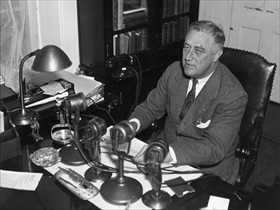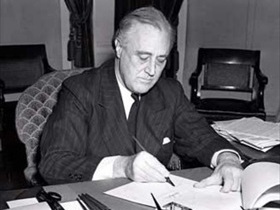PRESS LEAKS ROOSEVELT’S “VICTORY PLAN” OVER AXIS
Chicago, Illinois • December 4, 1941
Early in July 1941, just 4 months after the U.S. Congress had enacted the Lend-Lease Program that began assisting Great Britain and China in their defense against the aggressor states of Nazi Germany, Fascist Italy, and Imperial Japan, President Franklin D. Roosevelt requested his Secretaries of War and the Navy to prepare a comprehensive war program. The top-secret program was to address specific assumptions regarding materiel needs and potential U.S. adversaries and allies once America was drawn into the European conflict, which Roosevelt assumed would be within a year, as well as outline strategic and tactical guidelines to defeat America’s enemies. At the time of the president’s request most of continental Europe lay prostrate under the German jackboot. The military collapse of the Soviet Union, which Germany had assaulted the previous June with 3.9 million men, 3,350 tanks, and 4,389 airplanes in Operation Barbarossa, was one of the assumptions that was reflected in the 147-page “Victory Plan” (or “Victory Program”) submitted to the president in September.
Roosevelt was between a rock and a hard place as war clouds drifted across the Atlantic and over the American landmass in the summer and fall of 1941. He knew what measures the nation needed to embrace if it and the recipients of the Lend-Lease Program were to prevail over the forces of European fascism. But he also recognized that these measures, which included both a rapid military buildup plan for the anemic armed forces (at the start of 1941 there were just over 458,000 non-Coast Guard military personnel on active duty) and a mobilization plan for American industry, would be extremely unpopular with a majority of citizens if the measures became public.
But on this date, December 4, 1941, the Chicago Daily Tribune, owned by Republican Robert McCormick, a leading non-interventionist, America First isolationist, and no friend of the thrice-elected Democratic president, used a source from the War Department’s War Plans Division to publish details of FDR’s “Victory Plan”—including the assertion that the U.S. would not be able to field forces in strength against Nazi Germany “before July 1, 1943, due to a shortage of essential equipment.” The article, which also appeared in newspapers owned by two of McCormick’s first cousins, the New York Daily News and The Washington Times-Herald, specified in some detail how the Victory Plan was to be implemented. Secretary of War Henry L. Stimson called the source of the leak (never discovered) “wanting in loyalty and patriotism.” The German embassy in Washington was only too happy to cable summaries of the newspaper articles to Berlin, where military planners reexamined their own policies in light of the “incontrovertible intelligence” the articles provided. All the more reason, Germany’s leader Adolf Hitler believed, to quickly finish off the Soviet Union (at war with Germany since June 22, 1941) and Great Britain (at war with Germany since September 3, 1939) before America could intervene any further.
Alas, Japan sprang a nasty surprise on both Germany and the United States when it attacked the U.S. Pacific Fleet at anchor at Pearl Harbor, Hawaii, on December 7, 1941, just 3 days after McCormick & Co. had dropped their own bombshell. Hitler professed to his Foreign Minister, Joachim von Ribbentrop, that he had no alternative but to support his Tripartite treaty partner in the Far East. (In December 1941, the major players in the 9‑member Tripartite, or Axis, Pact were Germany, Italy, and Japan.) And so on December 11, 1941, Germany, followed by servile Italy, declared war on the United States. Upon the citizens of all 3 Axis countries and beyond, the global war would heap misery, poverty, death, and devastation on an unprecedented scale.
America’s Victory Plan Meant Becoming the “Arsenal of Democracy”
 |  |
Left: In a radio broadcast (a so-called “fireside chat”) delivered on December 29, 1940, Roosevelt promised to help the government of hard-pressed Great Britain fight Hitler’s Germany by giving it military supplies while permitting the U.S. to avoid actual combat with Britain’s enemy. Europe does “not ask us to do their fighting,” the president assured his listeners. “They ask us for the implements of war, the planes, the tanks, the guns, the freighters which will enable them to fight for their liberty and for our security.” As “the great arsenal of democracy,” the memorable phrase FDR used in his address, “we must get these weapons to them, get them to them in sufficient volume and quickly enough, so that we and our children will be saved the agony and suffering of war which others have had to endure.” Roosevelt pursued this topic in his annual State of the Union address to the U.S. Congress on January 6, 1941, initiating a debate on what was to become the U.S. Lend-Lease Program.
![]()
Right: The Lend-Lease Program became law on March 11, 1941, with the president’s signature. The program effectively ended the U.S. pretense of neutrality vis-à-vis Germany, Italy, and Japan. Lend-Lease provided for the procurement, manufacture, and transfer (by loan, lease, or sale) of defense items as well as food and services to countries whose defense was deemed crucial to the U.S. The Office of Lend-Lease Administration disbursed a total of $50.1 billion (equivalent to $901.85 billion in today’s dollars) in assistance. The money represented 17 percent of the total war expenditures of the U.S. In all, $31.4 billion went to Britain, $11.3 billion to the Soviet Union, $3.2 billion to France, $1.6 billion to China, and smaller sums to other Allies. The interest-free credit was used by Allies to acquire aircraft, ships, tanks, trucks and other vehicles, steel, munitions, petroleum products, army boots, cotton, and food. The terms of the agreement provided that any equipment was to be used until time for its return or destruction. In practice very little was returned. Canada operated a similar program called Mutual Aid that provided $1 billion in loans and $3.4 billion in supplies and services to Britain and other Allies.
U.S. War Department Film from 1942: “War Comes to America”
![]()

 History buffs, there is good news! The Daily Chronicles of World War II is now available as an ebook for $4.99 on Amazon.com. Containing a year’s worth of dated entries from this website, the ebook brings the story of this tumultuous era to life in a compelling, authoritative, and succinct manner. Featuring inventive navigation aids, the ebook enables readers to instantly move forward or backward by month and date to different dated entries. Simple and elegant! Click
History buffs, there is good news! The Daily Chronicles of World War II is now available as an ebook for $4.99 on Amazon.com. Containing a year’s worth of dated entries from this website, the ebook brings the story of this tumultuous era to life in a compelling, authoritative, and succinct manner. Featuring inventive navigation aids, the ebook enables readers to instantly move forward or backward by month and date to different dated entries. Simple and elegant! Click 











